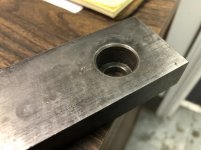Just bought a brown & sharp Micromaster and had a chance to use it at the warehouse where it was being stored. I didn't have a way of dressing the wheel but the previouse owner had one on there so I gave it a shot with vice jaw that was near by. I would have stoned the part and the chuck before starting but there were no stones to be had here.
I'm wondering if the finish looks correct or if there is chatter in it. It sounded fine while grinding compared to some of the videos I've seen, but this pattern left in the part makes me wonder if I was doing something wrong.

How the part looked before grinding (the other side)

I'm wondering if the finish looks correct or if there is chatter in it. It sounded fine while grinding compared to some of the videos I've seen, but this pattern left in the part makes me wonder if I was doing something wrong.

How the part looked before grinding (the other side)


